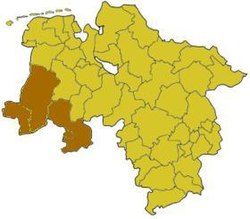Osnabrück administrative district
| Osnabrück administrative district | |
|---|---|
| Inventory period | 1885-1988 |
| Affiliation | 1885–1946 Province of Hanover 1946–1978 Lower Saxony |
| Seat | Osnabrück |
| surface | 6101 km² (1977) |
| Residents | 795,300 (1977) |
| Population density | 130 inhabitants / km² (1977) |

|
|

The administrative district of Osnabrück was an administrative district of the Prussian province of Hanover and the state of Lower Saxony . It existed from 1885 to 1978. In 1978 it was combined with the administrative district of Aurich and the administrative district of Oldenburg to form the administrative district of Weser-Ems , which in turn was dissolved on December 31, 2004 - like the other three administrative districts of Lower Saxony.
history
After the earlier duchy of Osnabrück, which fell to Napoleonic France in 1810, was annexed to the Kingdom of Hanover in 1813, a "government commission" was set up in Osnabrück, which was replaced in 1816 by a provincial government. The administrative district of this authority, which had its seat in the Osnabrück Castle, comprised the old prince-bishopric of Osnabrück, the Lower County of Lingen and the Emsland part of the Duchy of Arenberg-Meppen . In 1823 the provincial government was replaced by the Landdrostei Osnabrück , to which the county of Bentheim was now also subordinate.
After the annexation of the Kingdom of Hanover by Prussia in 1867, the Hanoverian administrative structures initially remained. In 1885 the Osnabrück administrative district was finally formed from the Osnabrück Landdrostei. The model was the government districts established in the other Prussian provinces in 1815/1816 . At the same time, the old Hanoverian administrative structure in cities and offices was replaced by a structure in districts . In 1895 the Osnabrück government moved into the newly built government building on Kanzlerwall, today's Heger-Tor-Wall.
In 1978, the Osnabrück administrative region became part of the Weser-Ems administrative region . The Osnabrück government building became the seat of the school department of the administrative district authority, the district government, and the office of the deputy head of the authority, the government vice-president. Since the dissolution of the Weser-Ems district government (late 2004), the former Osnabrück government building has served as the headquarters of the Osnabrück police department. It also housed parts of the Osnabrück department of the state school authority of Lower Saxony until the end of 2008.
In 1978, commemorative plaques were attached to the extension of the government building from 1956 to Rolandstrasse (since 1978 "Alte Synagogen-Strasse"), commemorating the Old Synagogue . It had been on this property since 1906 and was set on fire on November 9, 1938, whereupon the Mayor of Osnabrück at the time, Erich Gartner, ordered it to be demolished on the same day. He sought to swap the area with state-owned land at Osnabrück Castle .
Administrative division
In 1885 the administrative district of Osnabrück was divided into one urban district and ten rural districts :
In 1932 the Aschendorf district was merged with most of the Hümmling district to form the Aschendorf-Hümmling district. The remaining communities in the Hümmling district came to the Meppen district. Also in 1932 the Iburg district was dissolved and incorporated into the Osnabrück district. Since 1939, all districts in the administrative district were called Landkreis .
There were further extensive regional reforms in the 1970s. First in 1972 the districts of Bersenbrück, Melle and Wittlage were incorporated into the district of Osnabrück. In 1974, the external borders of the administrative district changed when Gehlenberg and Neuvrees were incorporated from the Aschendorf-Hümmling district to Friesoythe and Wachtum from the Meppen district to Löningen in the Cloppenburg district . At the same time, the three communities of Vörden , Hinnenkamp and Hörsten from the Osnabrück district were incorporated into Neuenkirchen in the Vechta district .
In 1977 the districts of Aschendorf-Hümmling and Meppen and most of the district of Lingen formed the new district of Emsland . From the district of Lingen, only Wietmarschen fell to the district of Grafschaft Bentheim. The administrative district of Osnabrück finally comprised the independent city of Osnabrück and the three districts of Emsland, Grafschaft Bentheim and Osnabrück. After its dissolution, the Osnabrück administrative district became part of the new Weser-Ems administrative district on February 1, 1978 .
District President
- 1885–1887: Gustav von Gehrmann (1823–1892)
- 1887–1900: Gustav Stüve (1833–1911)
- 1900–1901: Georg von Heydebrand and the Lasa (1853–1901)
- 1902–1908: Friedrich von Barnekow (1848–1908)
- 1908–1909: Philipp von Baumbach (1860–1911)
- 1909–1917: Richard von Bötticher (1855–1934)
- 1917–1922: Albert Tilmann (* 1867)
- 1922–1933: Adolf Sonnenschein (1886–1965)
- 1933–1937: Bernhard Eggers (1882–1937)
- 1938–1944: Wilhelm Rodenberg (1892–1955)
- 1944–1945: Hans-Joachim Fischer (1904–2000)
- 1945–1951: Johannes Petermann (1886–1961)
- 1951–1967: Egon Friemann (1906–1967)
- 1967–1975: Josef Zürlik (1910–1993)

